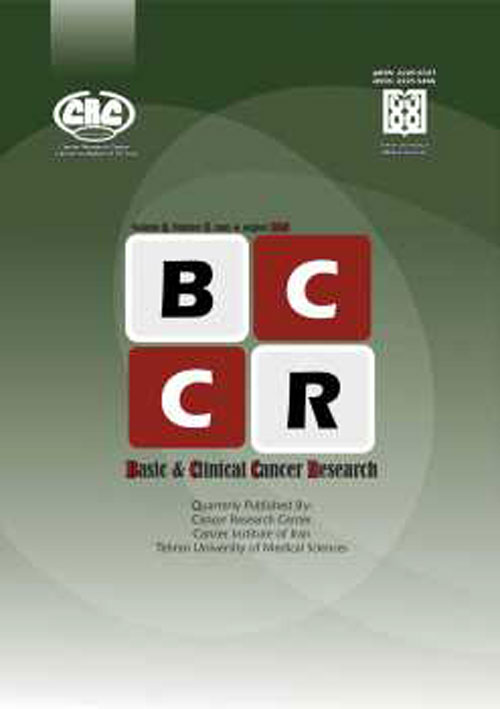فهرست مطالب

Basic and Clinical Cancer Research
Volume:9 Issue: 4, Autumn 2017
- تاریخ انتشار: 1396/10/30
- تعداد عناوین: 6
-
-
Pages 4-12BackgroundPhysical activity has beneficial effects on the elderly susceptible to the development of cancers, through maintaining a healthy body condition and improving the state of disease. In the present study, we investigated the variation of cancer-related biomarkers, such as Carcinoembryonic Antigen (CEA) and Cancer Antigen 15-3 (CA 15-3) following eight weeks of aerobic exercise in middle-aged women with breast cancer.MethodsIn this quasi-experimental study, 15 females with breast cancer with mean age (44.46±17.15 years of age), weight (70.53±5.18 kg) and body mass index (27.58±2.18 kg/m2) were selected and considered as the experimental group. The exercise program consisted of 8 weeks of aerobic exercise; three sessions per week for 40-60 minutes and with an intensity of 30%-60% heart rate reserve (HRR). Before and after the experiment, while all patients were fasting for 12 hours and did not have any vigorous physical activity for 24 hours, the level of CEA and CA15-3 was measured. Data were analyzed by paired sample t-test at a significance level of PResultsFindings showed that the tumor markers (CEA and CA15-3) levels did not change significantly after 8 weeks of aerobic exercise (P=0.542 and P=0.091); while there was a significant decrease (p=0/001) in body mass index, body fat percentage and weight in middle-aged women with breast cancerý.ConclusionWe suggest that exercise for 3 days per week improves body composition indices, without increasing the level of fatigue or stress values, which may contribute to prevent cancer prevalence in elderly women.Keywords: Exercise, Carcinoembryonic Antigen, Cancer Antigen 15-3, Women, Breast Cancer
-
Pages 13-21BackgroundLung cancer is one of the most common malignant tumors with poor survival, which is usually diagnosed at advanced stages. In recent years, increasing evidence has revealed that circulating miRNAs exhibit great potential in screening and early detection of various types of cancers including lung cancer. miR-21 is one of the most highly expressed members of the microRNA family in many human cancer types.MethodsThe authors analyzed miR-21 expression in matched tumor and normal tissues and plasma in 17 patients affected with non-small cell lung cancer. Samples were collected from the NSCLC patients before surgery, radiotherapy or chemotherapy. Expression levels of tissue miR-21 were assessed, using TaqMan RT-PCR assay. Expression levels of plasma miR-21 were assessed, using LNA RT microRNA PCR primer set and SYBR green qRT-PCR assay.ResultsmiR-21 expression was higher in 9 out of 17 patients plasma samples. No change in miR-21 expression was observed in 8 plasma samples. In lung tissues, ten patients showed up-regulation of miR-21 and six patients were down-regulated. One patient had no change in miR-21 expression level in tissue samples. The expression level of mir-21 in tissue and plasma was concordant in 6 patients.ConclusionIt seems that the level of miR-21 in plasma samples of NSCLC patients as a marker for screening needs more investigation.Keywords: Non-small cell lung cancer, miR-21, plasma, tissue
-
Pages 22-31BackgroundWe aimed to explore opinions of breast cancer patients and clinicians in Iran about a patient decision aid (PDA) for breast-conserving surgery.MethodsWe conducted a qualitative study and evaluated the opinions of breast cancer patients and clinicians about a PDA for breast-conserving surgery in the Cancer Institute of Iran. We applied Barun and Clarkes thematic analysis approach for data analysis. We categorized the results into three themes including perceived advantages, perceived disadvantages, and suggested strategy and seven subthemes.ResultsBoth patients and clinicians believed that PDA was useful for improvement of breast cancer conserving surgery and quality of care among Iranian patients. In contrast to the clinicians, the patients were interested in knowing more about surgery techniques. Both groups believed that considering the cultural issues in the adaptation process is essential and families (i.e. husband) should be involved in the decision-making process in Iran.ConclusionPDA is a useful tool for implementation of breast cancer conserving surgery in Iran and other low and middle-income countries. However, it should be adapted based on the context and cultural issues in each country. We recommend implementing PADs in the routine practice for increasing breast-conserving surgery in Iran. However, further research is needed to reach an optimal PDA for Iranian patients.Keywords: Breast cancer, Breast conserving, Patient decision aid, Qualitative study
-
Pages 32-39Soft tissue metastases are extremely rare in differentiated thyroid cancers. We hereby present a man with a history of papillary thyroid cancer (PTC) at the age of 46, who was referred to cancer Institute due to raised serum thyroglobulin (Tg) and a new mass in the thigh. Imaging studies were suggestive of recurrence of the disease in the tumor bed, neck nodes and lungs, and also a mass in his left thigh, based on positron emission tomography (PET) scan, without radioactive iodine uptake. The excision of the mass revealed metastatic PTC. After management of symptomatic local recurrence with external beam radiotherapy (EBRT), he received sorafenib. After three years he is doing well and serum Tg is stable.Keywords: Papillary thyroid cancer, muscle metastases, FDG-P
-
Pages 40-44The Occupational/Environmental Cancer Workshop was organized as part of the International Congress on Cancer Prevention & Early Detection in Tehran, January 29-30, 2017. There were 42 participants representing professionals from ministry of health, public health sector, medical universities, and for health sector on issues of national cancer and archiving the information national exposures, asbestos and silica , wresearch organizations., as well as the young scientists, postdoctoral and PhD-students. The participants were intensively engaged in the workshop, the discussions were very active and various proposals were prepared in 4 subgroups dealing with environment, occupational exposures, issues on the use of asbestos and silica, and on the registration and recognition of environment/work related cancers.

